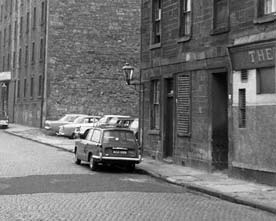The Whye Not.
117 Bishop Street, Anderston.
The Whye Not.
The pub sat at the corner of 117 Bishop Street, and William Street, Anderston.
It was originally called Gilmour's Bar. Hugh Gilmour the owner of the pub in the 1890s had other premises in the city, the most famous one still survives today and is known as Thomson's Bar, 579-81 Springburn Road which he took over in 1886, his other two public houses were Ruxton's Bar, at 21 Elderslie Street and 39-41 Cowlairs Road, this pub is better known as the Highland Fling in Springburn area, north of Glasgow.
The Bishop Street premises were sold to well known and respected publican Francis Meichen in 1900. Mr Meichen also ran a pub at 56 Dale Street, Bridgeton, which he took over in 1888, and 326-28 Possil Road, acquiring it in 1890. Other pubs Francis Meichen had were the Old Toll Bar, Paisley Road West and Meichen's Bar in Parliamentary Road and the Old College Bar on the High Street.
In 1908 the Bishop Street premises were sold to publican Patrick Shanley, he also ran a pub at 394 Parliamentary Road at the corner of Calderwood Street, which he acquired two years later. Mr Shanley continued in the pub in Bishop Street until the end of the 1930s.
After World War Two Daniel R Anderson took over the business, he also ran a successful pub at 79 Main Street, Bridgeton. The name of the pub then was "The Exchange Bar." In 1947 Mr Anderson was residing at 8 Moraine Avenue, Drumchapel. His wife Mary continued as licensee until the pub finally closed down and demolished in the mid 1960s, when most of the buildings in Bishop Street and William Street were flattened.
The pub had three rooms two of which were male only and the other room was the only one which women were allowed to enter, in fact they were not even allowed to purchase alcohol at all.
The cellar which was below the pub and often quite damp had a massive rodent infestation. Manager Denis Challans used to bash the cellar flap with an old wooden truncheon to scare the rodants. Many of Glasgow's old pubs had a cat living on the premises this helped to reduce the number of rats in the cellars.
End.

